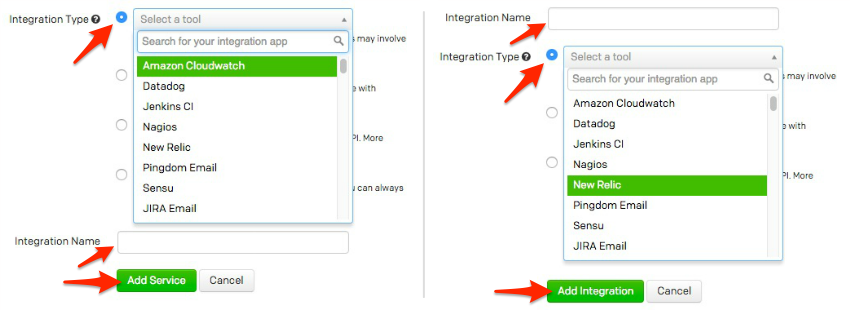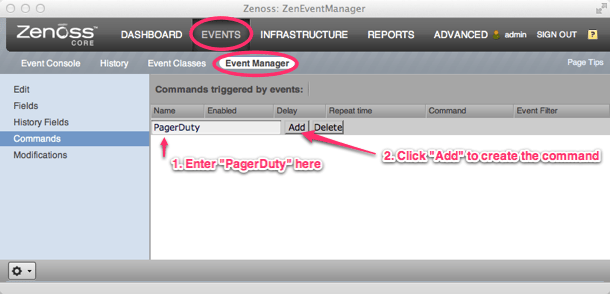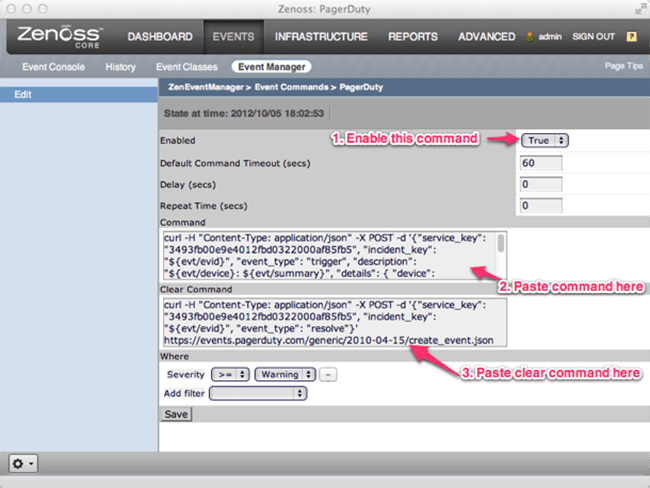Start Using PagerDuty Today
Try PagerDuty free for 14 days — no credit card required.
Zenoss 3 is a very popular open source network, server and application monitoring system used by thousands of IT organizations. It provides one of the best event management systems available in any open source monitoring system. The plug-in architecture of Zenoss allows it to be extensible by anyone.PagerDuty extends Zenoss’s functionality by providing on-call scheduling, alerts and incidents tracking through the PagerDuty API. You are notified of the most critical Zenoss events by PagerDuty so you are able to take immediate action.This guide describes how to integrate your Zenoss installation with PagerDuty using cURL. You might need to slightly alter these instructions depending on your exact Linux distribution and your Zenoss configuration. If you are having trouble completing the installation, please contact us.
From the Configuration menu, select Services.
On your Services page:
If you are creating a new service for your integration, click +Add New Service.
If you are adding your integration to an existing service, click the name of the service you want to add the integration to. Then click the Integrations tab and click the +New Integration button.
Select your app from the Integration Type menu and enter an Integration Name.
If you are creating a new service for your integration, in General Settings, enter a Name for your new service. Then, in Incident Settings, specify the Escalation Policy, Notification Urgency, and Incident Behavior for your new service.
Click the Add Service or Add Integration button to save your new integration. You will be redirected to the Integrations page for your service.

Install cURL and its dependencies on the machine running Zenoss (if not installed already):For Debian, Ubuntu, and other Debian-derived systems:
sudo aptitude install curlRHEL, Fedora, CentOS, and other Redhat-derived systems:
sudo yum install curlLog into your Zenoss Console
Click on the Events tab
Click on the Event Manager sub-tab
Click on the Commands link on the left panel
Add a new command by entering the name “PagerDuty” and then click the Add button
Click on the “PagerDuty” command to view the command details
Enable the command by selecting “True” for the label titled “Enabled”
Copy and paste the following into the field labeled “Command”:
curl -H "Content-Type: application/json" -X POST -d '{"service_key": "YOUR-SERVICE-KEY", "incident_key": "${evt/evid}", "event_type": "trigger", "description": "${evt/device}: ${evt/summary}", "details": { "device": "${evt/device}", "ipAddress": "${evt/ipAddress}", "severity": "${evt/severity}", "summary": "${evt/summary}", "message": "${evt/message}", "evid": "${evt/evid}"} }' https://events.pagerduty.com/generic/2010-04-15/create_event.jsonNOTE: PagerDuty does not accept invalid JSON including unescaped newline characters. Please verify within your Zenoss configuration that no Zenoss variables contain invalid JSON data.
Replace YOUR–SERVICE–KEY with the key from PagerDuty
Copy and paste the following into the field labeled “Clear Command”:
curl -H "Content-Type: application/json" -X POST -d '{"service_key": "YOUR-SERVICE-KEY", "incident_key": "${evt/evid}", "event_type": "resolve"}' https://events.pagerduty.com/generic/2010-04-15/create_event.json
Replace YOUR–SERVICE–KEY with the key from PagerDuty
Click on the “Save” button at the bottom to save the changes
At the moment, if the event command fails to submit notifications to PagerDuty, it will be registered as another event in Zenoss. The repeat time can be set in command settings such that notification would be retried. Note: PagerDuty will deduplicate events based on the event id, thus only one PagerDuty incident would be created even if Zenoss submits events multiple times.You should also configure an external ping check service to monitor your site’s external connectivity. Of course, you can use PagerDuty to forward alerts from these services as well.
This is easy to do with the current integration, as a Zenoss integration in PagerDuty is directly mapped to an “Event Command” in Zenoss.In order to setup multiple integrations, just duplicate the existing event command rename it (i.e. pagerduty_database, pagerduty_network, etc.) and update the command with the appropriate integration key. Don’t forget to set filters on the command such that only the desired events are sent to PagerDuty.
Try PagerDuty free for 14 days — no credit card required.